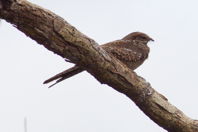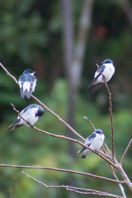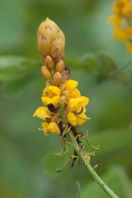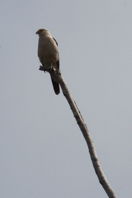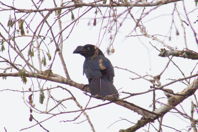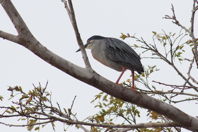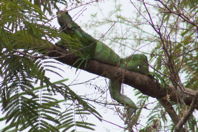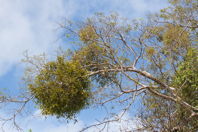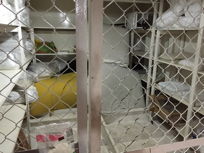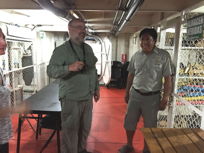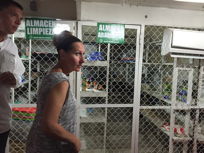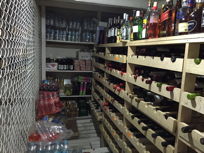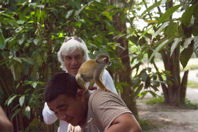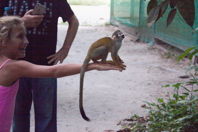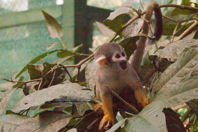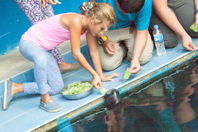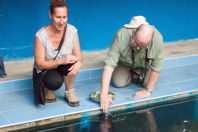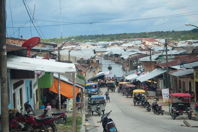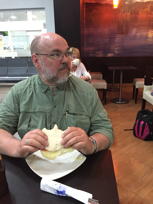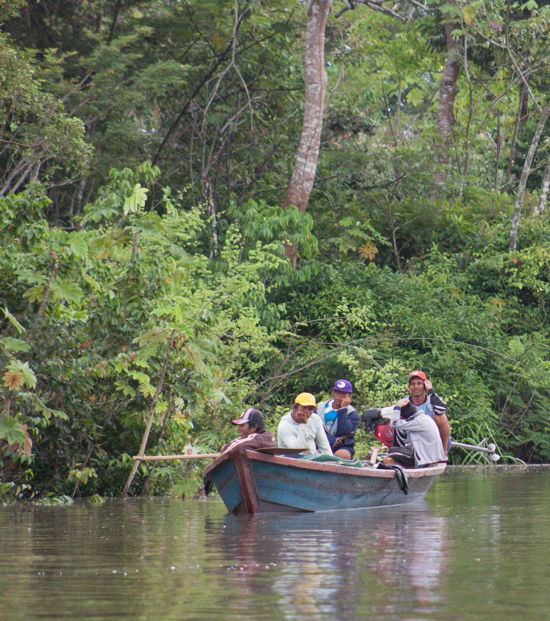
|
|
The first photograph of the day, as we were out on a skiff
excursion. Five local men in a low-riding outboard boat. But is the guy at the right on a phone? (Pass your mouse over for instant expansion; click for large view.) |
Sunday, April 19, sixth day in Perú
On the Amazon, then Iquitos
|
This is probably what you think of when you hear “Amazon
jungle”: dense, mysterious, overhanging, impenetrable. (50-second clip) |
Two skiff excursions this morning, one at 7:00, the other at 9:00. Lots of birds both times, but we got five iguanas in the later trip, and saw some monkeys then too.
For the pictures to the left, I’m depending on Mark and the list furnished by the naturalists on board for the identifications, but four at the top left are White-winged Swallow but we’re in the dark as to what that flower is. It looks like a legume of some sort, that’s all I can contribute. I’m especially fond of the pictures that I took of the nightjar sitting on a branch. I’ve been interested in these birds all my life, and this is the only one I’ve ever seen up close. (Notice the rictal bristles around this one’s mouth.)
To tell the truth, I was getting antsy to be on the way and making perceptible progress towards the next stage of our adventure. At 11:30, our checkable bags were to be outside the room, which meant that before our 6:30 wakeup call, we had to make sure that these bags were all shipshape. Paying the bar bill was supposed to be done by 11:00, but at that time we had not yet gotten in range of internet connection. So we had to wait till after lunch for that, and even then, the connection was so bad that Mark gave up and we pooled our resources in soles to take care of the S/314 bar bill. A hundred dollars for Pisco Sours! (But oh, so, so good.)
My journal is silent on it, but we were given the opportunity to tour the crew’s part of the Delfin II, below decks. This would be just before lunch. Only a few of us accepted the offer: Melissa and Steve, Mark and I, and Mark from the other American couple.
We met Chino at the head of the steep and narrow descending stair, and he led us down into the hellishly noisy environment that the crew had to endure when they were not at work. For us up above, the surroundings were unusually roomy: Mark’s and my cabin had space to spare. Down here, the crew’s bunks were packed tightly and everything was cramped. The pictures in the block to the right are pretty much self-explanatory, except that I held my iPhone right up to a gap in the the chain-link that kept the liquors and wines locked up. A nice selection, all in all.
Last stop was the engine room, even noisier than the rest of the below-decks. Big diesels for moving us about and also for generating the electricity. We saw the water-supply system, and any number of other essentials that you don’t think about or worry your pretty little head over when you’re vacationing.
Our last lunch on the Delfin II was very fine. A ceviche appetizer with a pleasantly spicy sauce made from those superhot little chilis that they had earlier told us not to eat. Then a rolled fillet of river bass on steamed vegetables (strips of eggplant, yellow squash, and another vegetable, white, that almost could have been jicama), and puréed beans. Finally a dessert of ice cream finished this last meal (sob).
When it was time to debark, we went by skiff to the same place in Iquitos that we had left from, the previous Wednesday night. It was hot as hot can be when we emerged onto the street, and we were to the same degree glad to get into an air-conditioned van.
We drove by a seemingly devious route through Iquitos to the Manatee Rescue Center, where we got a good explanatory spiel by a young docent, whom you can see in the top-left picture to the right. There was a tame and compliant squirrel monkey that entertained us for a bit, there, and then we went to see the rescued manatees in a tank. Some of us fed them, too.
Unlike the river dolphins, the manatees are not protected by local superstition. People hunt them for food, and attempt to keep babies for pets, which always leads to their death because they must nurse for over a year. So these animals unquestionably need extra help.
| Feeding the manatees. Mark and Melissa got the opportunity to do this too. |
From there, we rode through the district of Belén, a favela if ever there was one. People live crowded in a low-lying area that is flooded through all the rainy season, and endure all the ills that you can imagine from overcrowding, proximity to and immersion in the river, and overwhelming poverty. One of our group had remarked after our visit to Puerto Miguel, where we had bought a few things at the local market the day before, that he thought that people lived a pretty miserable life there. I said to him, after we had driven through Belén, “Don’t you think that people in Puerto Miguel are living a better life than all these people here?”, and he had to agree. After you look at the one picture I’m showing here of the town, you might read the Wikipedia article about it. Javier told us that when people’s houses got flooded out when the river was highest, they just moved into friends’ houses. I was astonished at the number of lumberyards in the higher levels, though: people clearly are building at a great rate.
Then we drove around Iquitos itself, looking at the architecture and ending at the Plaza de Armas, central square of the city. In the 1880’s, the place was a thriving rubber town, and the wealthiest industrialists there built elegant houses in the neighborhood of the Plaza, but for the most part these have not been maintained. It’s picture of decayed opulence. There’s even a cast-iron house, of perhaps more architectural interest than the cast-iron building fronts in downtown Manhattan, but it too, is much the worse for wear.
Finally, we drove to the airport, where Javier and Rudy oversaw much of the detail of baggage-mangling. My journal rather laconically says, «Now we sit at a little café in the waiting room, until our flight is called.» I didn’t write about how meager and uninspiring the food selection was in the café. Especially after the meals on the Delfin II, which were almost uniformly superb.
We landed in Lima after an uneventful flight, and were met by a pleasant young woman who walked us across the street to the Airport Hotel, for a short stay. And thus ends our adventure for this day; to find out what happened on the next day, you’ll have to read on.
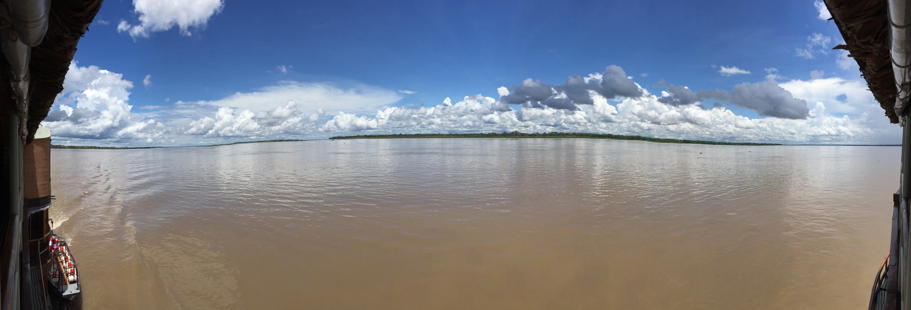
|
|
The muddy Amazon, with pure blue sky above. An iPhone panorama, in which
you see the forward side of the vessel to the right, and the aft to the left. You can see one of the skiffs tethered near the stern. |
